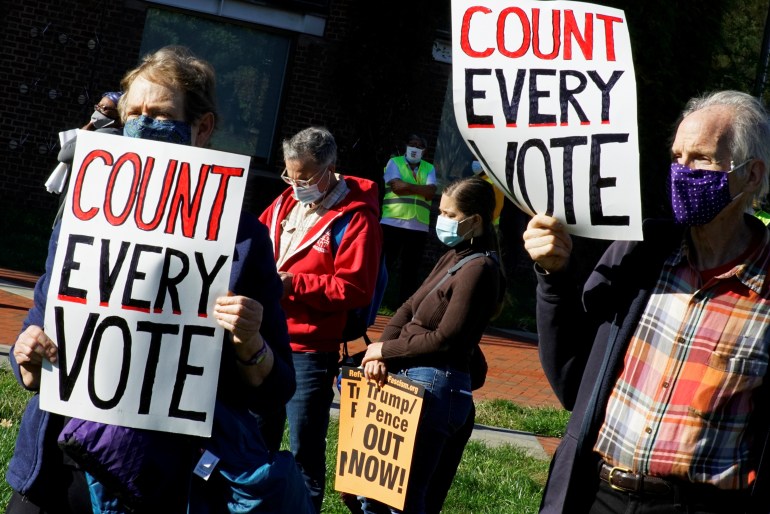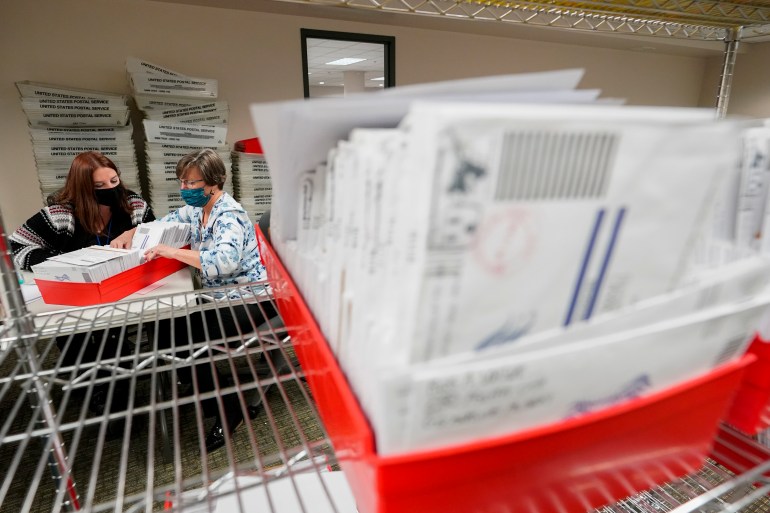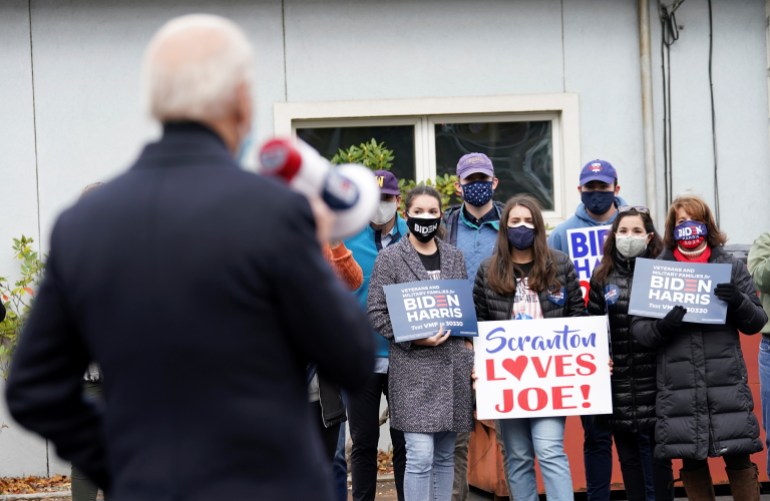US Elections: How Biden flipped battleground Pennsylvania
Experts say Joe Biden appealed to white, working-class voters in battleground Pennsylvania, propelling him to the White House.

Philadelphia, Pennsylvania, US – The Associated Press declared victory for United States presidential candidate Joe Biden on Saturday morning after he outpaced incumbent Donald Trump in Pennsylvania.
Biden won the state and the presidency not because he was a particularly beloved candidate, according to experts and recent opinion polls in Pennsylvania, but because voters saw him as a better option than Trump.
Keep reading
list of 4 itemsTrump ally Rudy Giuliani files for bankruptcy following defamation case
‘Insurrection’ should bar Donald Trump from US presidency, lawyers argue
Ex-Proud Boys leader Joseph Biggs sentenced to 17 years for US Capitol riot
Growing up in Scranton, a city in the state’s northeast, also gave the former US vice president a home-field advantage, allowing him to appeal to white, working-class voters.
“Joe Biden is not the darling of lots of voters,” Christopher Borick, a professor of political science and director of the Muhlenberg College Institute of Public Opinion, told Al Jazeera.
A recent institute poll found only 49 percent of Biden voters were very enthusiastic about voting for him, compared with about 82 percent of Trump voters who said they were very enthusiastic to vote for their candidate.
“In the end, there was enough enthusiasm against Trump that even if people weren’t in love with Joe Biden, they certainly were able to vote for him,” Borick said.
In a vote count that dragged on for days, Biden urged patience while Trump falsely declared victory and launched a volley of legal challenges in the state. Experts say the campaign’s litigation is unlikely to make a significant difference to the ballot count.
Pennsylvania saw a “red mirage” with a strong early lead for Trump, followed by a dramatic “blue shift” in favour of Biden.
Under state law, officials could not count mail ballots until Election Day, and those ballots take longer to count because they must be removed from two envelopes – a regular envelope and a secrecy envelope – before they can be verified and scanned.
Trump supporters were more likely to vote in-person, while Biden supporters preferred mail ballots. The faster processing of in-person votes gave Trump a lead on Wednesday morning of about 675,000 votes, but as workers processed the mail ballots, the race narrowed. On Friday morning, Biden took the lead.
How Biden won
In 2016, Trump won the presidency by flipping the rust belt states of Wisconsin, Pennsylvania and Michigan, all reliably Democratic since the 1980s. In 2020, Biden restored all three to their blue roots by appealing to white working-class and suburban voters who were disillusioned with Trump.
Biden’s victory can be attributed to a combination of Trump’s inability to build on his 2016 victory, voters on the left who were determined to vote the Republican leader out and Biden’s ability to hold the middle, experts told Al Jazeera.

Borick said Biden won Pennsylvania with lots of little incremental improvements over Hillary Clinton, the Democratic candidate in 2016. “It’s not like this is some gigantic sea change from four years ago,” he said.
Looking across the map of Pennsylvania, Biden only flipped two counties from Trump – Northampton and Erie counties – while all the others had the same winner, but with better margins for Biden.
This election saw a high turnout on both sides. In the last four years, Republicans registered a huge number of voters across Pennsylvania and built infrastructure to get them to the polls. That work resulted in a higher turnout for Trump.
In the end, there was enough enthusiasm against Trump that even if people weren't in love with Joe Biden, they certainly were able to vote for him
For his part, Biden registered a higher turnout in Pennsylvania than Barack Obama. He also improved on Clinton’s performance in the suburbs, where he peeled some voters away from Trump.
Amy, a 67-year-old from Chester County, a suburb outside Philadelphia, who only gave Al Jazeera her first name, said she voted for Trump in 2016 because she disliked Clinton. This year, she voted for Biden – but not because she likes him.
“About a year ago I told myself, you’re an absolute idiot and I will never do it again,” she said. “I voted against Trump.”
Biden v Clinton
While some voters did not see Biden as loveable, he still improved over Clinton, who was deeply disliked in Pennsylvania.
“One difference, and you have to put it on the table, is that Pennsylvania has never elected a woman governor or senator, and has a bad track record of electing women to Congress over time,” Borick said.
“How much a role gender may have played in this is hard to discern, but it has to be considered in Pennsylvania, given its track record.”

Gender is not the only factor, though: Biden’s campaign also invested more time in Pennsylvania. “He started his campaign here, he set up his campaign headquarters here and his personal narrative always starts with Pennsylvania,” Borick said.
In 2016, Trump’s anti-immigration, “Make America Great Again” rhetoric resonated across the country in white, working-class towns struggling with deindustrialisation and out-migration, including in Pennsylvania.
But Biden was able to connect to those voters in a way that Clinton could not. While Clinton’s father is from the small city of Scranton, Lackawanna County, Biden himself was born there.
“I grew up three miles from where Biden grew up,” Borick said, adding that he can tell Biden has a true love of Scranton. “It’s not a show, you could tell, it’s authentic. He truly loves it, he can talk about it, he knows it.”
In 2016, Clinton won Lackawanna County by 3.5 points. On Friday night, Biden was leading by nine points. In 2016, Trump won neighbouring Luzerne County by 19 points, while on Friday night, Trump was leading by only 15 points.
“Trump won the state by less than 1 percent,” Borick said. “You just have to improve enough, and it looks like that’s exactly what Joe Biden did.”
Can Trump litigate his way to victory?
Anticipating Pennsylvania would turn blue, the Trump campaign filed a flurry of litigation.
It asked the Supreme Court to intervene in a case regarding mail ballots postmarked on Election Day but received later. It also filed a lawsuit accusing Philadelphia officials of “hiding” the ballot count, and that claim briefly slowed the ballot count on Wednesday. The campaign also sued to stop a deadline extension for mail voters to provide missing ID to “cure” their ballots.
Rebecca Green, a lawyer specialising in election law, said asking for greater transparency would not affect the count. “I have seen no evidence that state officials have not been following the law,” she said. “There is already quite a bit of transparency built into the system.”
She said a recount in Pennsylvania is unlikely to make a big difference because historically, recounts do not change the totals by much. “If you’ve got a 20,000 vote lead or a 40,000 vote lead, it’s very unlikely a recount will upset that.”
If you’ve got a 20,000 vote lead or a 40,000 vote lead, it’s very unlikely a recount will upset that
Lawsuits claiming widespread voter fraud also will need to be backed up by evidence, she said.
As of Friday, Pennsylvania election officials said the election had gone remarkably smoothly and there were no known cases of widespread voter fraud. “It remains to be seen whether the Trump campaign can provide evidence of the claims it’s making,” Green said.
The campaign has also asked the Supreme Court to rule on whether Pennsylvania had the authority to set a rule allowing any mail ballot postmarked on Election Day but received up to three days later to be counted.
The court stayed the decision, meaning it did not change the state’s rule. Green said even if the Supreme Court rules in the Trump campaign’s favour, the court might still allow those votes to count.
“Those voters were following the rules as they stood on the day they put their ballots in the mail, so it’s not a foregone conclusion that the Supreme Court, even if it agreed on the merits, would invalidate those votes.”

Finally, the campaign filed a lawsuit to stop a deadline extension for mail voters to provide missing identification. The campaign alleged that not every voter had the ability to “cure” their ballot, raising a possible equal protection violation.
Green said this would affect a very small number of votes, and the argument would run up against the fact that the US voting system is “incredibly decentralised” and voters are subjected to different standards depending on where they live.
She said that, ultimately, if Biden wins by hundreds of votes, the Trump campaign lawsuits may cut into Biden’s lead, but with a margin of approximately 34,000 votes on Saturday morning, it is hard to see the litigation having an impact.
